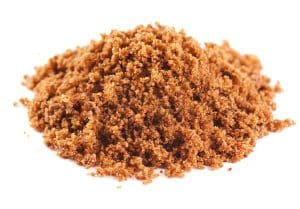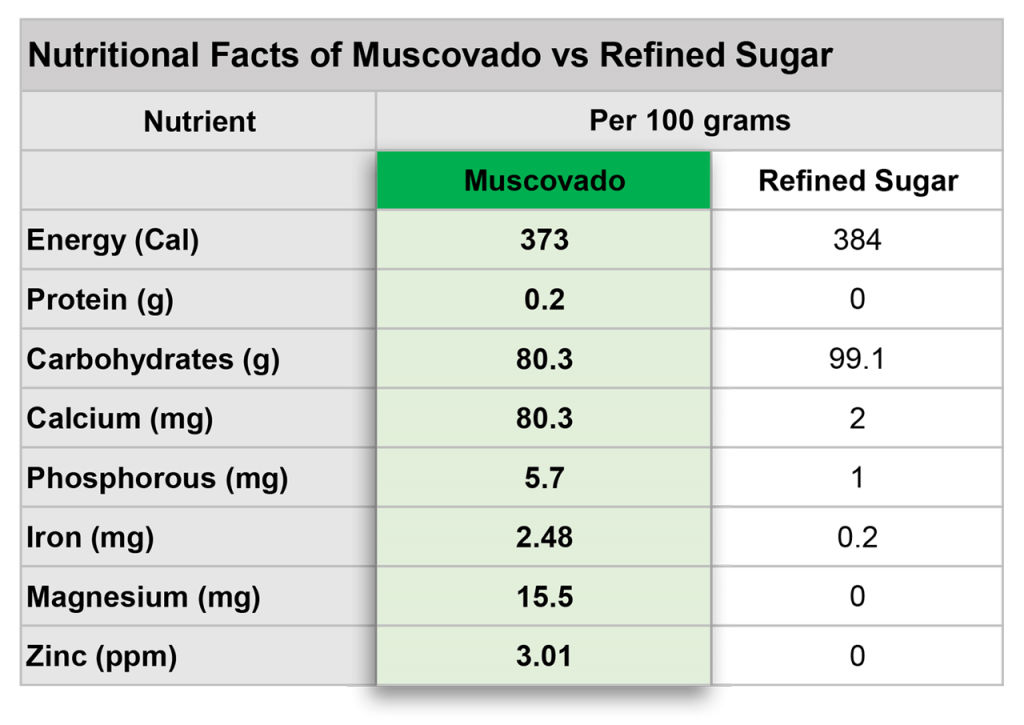What Is Muscovado Sugar – a.k.a. dark sugar?

Muscovado sugar also called dark muscovado sugar, or raw sugar is the least refined type of sugar made from sugar canes. It is a pure, wholesome, natural form of sugar that is comparable to that of honey due to its high nutritional value. Muscovado sugar is high in minerals and natural vitamins and is rich in anti-oxidants. It is also a good source of fiber and is considered an excellent sweetener for people who are on a low-carb diet.
It is one of the healthier alternatives to refined white sugar available in the market today. Gone are the days that muscovado, when served side by side with central sugar and white (refined) sugar, is less valued.
Commercial brands, which are now readily available, are better tasting than the muscovado sugar in the earlier days.

History of muscovado sugar
The name comes from the Portuguese word mascavado that means unrefined. Muscovado sugar has been produced in the West Indies and parts of South America since the early 1800s. It was shipped in wooden barrels to England, where it was used by bakers, confectioners, and the general public.
The production of sugar began in northern India after the introduction of sugarcane by traders from Island Southeast Asia at around 1000 BCE. The exact date of the first cane sugar production is not known. The earliest evidence of sugar production can be found in ancient Sanskrit and Pali texts. The Abbasid Caliphate in the Mediterranean, Mesopotamia, Egypt, North Africa, and Andalusia was introduced to sugar from medieval India around the 8th century. According to sources, every village in Mesopotamia grew sugarcane by the 10th century.
The British Empire traded sugar. Sugarcane was produced in British colonies in the West Indies and India, as well as in other territories including Cuba, the French West Indies, Java, Brazil, Puerto Rico, and the Philippines. Slavery or indentured servitude were often used in sugarcane production. In the past, raw sugar was shipped to Europe or to New England where it was refined or distilled into rum, which was re-exported to higher prices. Bihar has a sugar refinery in eastern India.
The raw sugar or muscovado was brought to port in a variety of impurities that could be sold directly to the market for making alcohol. In the British Empire, sugars with a high molasses content were referred to as muscovado, while sugars with a low molasses content were called brown sugar.
How is muscovado sugar produced?
The process of producing muscovado sugar is fairly straightforward and simple. Sugarcane is harvested, crushed, and juiced, and the juice is boiled until it reaches the desired level of concentration.
The liquid is then poured into pans to allow it to crystallize and dry. The resulting moist sugar crystals are then ground.
The solid sugar is then packed into containers and stored to allow it to dry further.
During this time, the sugar continues to absorb moisture. To make sure that the sugar is dry enough to store, it is tested with a hydrometer. The sugar is placed in a container with a small hole in the cap.
The hydrometer is placed in the container and the cap is tightened. The hydrometer measures the density of the sugar solution. If it is above a certain point, the sugar is considered to be dry. The heavier the sugar, the higher its density.
So if you have a sugar solution that is heavier than water, it contains more sugar than water. To make a syrup that will keep its sweetness, and not crystallize, it is important to have the right amount of sugar.
If you have too much sugar, the syrup will crystallize, and that means that you’ll have to melt it again and throw it away. If you don’t have enough sugar, it will get sour.

Is muscovado sugar vegan?
Muscovado sugar is vegan. It is not processed using animal products. Many vegans began using muscovado sugar for cakes and desserts.
It is also used in many vegan recipes for savory recipes. It is a bit of a thick sugar but has an amazing flavor.
You can use it in everything from vegan gravies and sauces to marinades and rubs to soups and stews. It is a dark brown color and is the perfect substitute for unnatural brown sugar.
Countries that produce muscovado sugar
Muscovado sugar is produced in many countries including Barbados, Belize, Brazil, Cameroon, Australia, South Africa, India, Jamaica, Malawi, Mauritius, Papua New Guinea, Philippines, Sri Lanka, Guyana, Tanzania, Uganda, United States, and Zambia.
Popular uses of muscovado sugar
The deep flavor of muscovado sugar is often applied in cakes and cookies. It pairs well with chocolate-baked goods. It makes a delicious caramelized ice cream if you match gingerbread and similar dark-flavor sweets.
Muscovado sugar is an important ingredient in local delicacies, drinks, jams, and root crop delights. It is an essential ingredient in the production of chocolate and it meets the growing demand for superior natural and organic health foods.

Here are other popular uses of muscovado sugar nowadays,
- Coffee – muscovado sugar is best paired with coffee.
- Chocolates – many chocolate producers and manufacturers are now using muscovado sugar as it blends well with cocoa.
- Sauces – muscovado sugar has become a popular replacement to brown sugar in making sauces like barbeque sauce for improved, deeper smoky flavor.
- Milk tea pearls – milk tea stands are popping up everywhere. Many of these shops now use dark muscovado sugar instead of the typical, commercial brown sugar to make pearls and as sweeteners to their milk tea products.
- Gingerbread – Plenty of bakeshops are now using muscovado sugar over brown sugar to make bread like gingerbread to have an even stronger molasses flavor.
- Marinades – many people love to use muscovado sugar mixed with olive oil, acid, herbs, and spices to marinate meat for grilling or roasting.
- Ice cream – At muscovado.ph, we are receiving bulk orders of our organic muscovado sugar from ice cream makers in South Korea as one of their primary ingredients and sweetener.
- Oatmeal – easily sprinkle muscovado sugar powder on top of your oatmeal to improve the taste.
- Non-sweet fruits – Many Filipinos love to put muscovado sugar on their avocado or any other non-sweet fruits for healthier snacks or meals.
- Popcorn – Muscovado sugar has slowly become the go-to sweetener for popcorn as it adds deep caramel flavor because of its molasses content.
- Salad dressing – Many have discovered that using light muscovado sugar in salad dressing will create a caramel-like taste.
Tips for Using Muscovado Sugar
If you’re new to muscovado sugar, you may be wondering what recipes it’s best for and how to use it in cooking. Muscovado sugar can be used in any recipe that calls for a sweet, toffee-like caramel flavor.
It’s great in coffee, tea, cereal, cakes, and cookies, and in desserts like caramel sauce, ice cream, and frosting. It’s also delicious used in marinades for meat, fish, and chicken or sprinkled over plain yogurt.
Muscovado compared to other alternatives
There are plenty of muscovado sugar substitutes out there. In this article, we will be comparing muscovado sugar with the following popular sweeteners.
- White / Refined Sugar
- Honey
Muscovado Sugar vs. Refined Sugar
Another alternative to muscovado sugar is refined sugar or mostly called table sugar because it can be found in many homes. So what are the differences between these 2 sugars?
Refined sugar is made from sugar cane. The refining process removes about half of the sugar cane’s natural vitamins and minerals. It is bleached to remove color and impurities. It is pure white and it contains no molasses. It is 99.9 percent sucrose.
Muscovado Sugar is 100% unprocessed sugar cane juice that has been evaporated, leaving behind the natural molasses content, which is usually thrown away. Muscovado is slightly stronger in flavor and more rustic. On the other hand, white, refined sugar is made by refining the sugar cane juice to remove the molasses. Sugar is refined to make it white, to improve its crystal shape, and to increase the duration that it will stay sweet. Refined sugar is also bleached, which entails heating it to high temperatures or treating it with oxygen and chemicals, to make its color whiter. Refined sugar is more easily dissolved than unrefined sugar.

Muscovado Sugar vs. Honey
Muscovado and honey are two widely used sweeteners that have very different and distinctive tastes and textures. You may like the taste of molasses and brown sugar for baking, but prefer honey on your morning toast.
Honey may have a better reputation and can be a good muscovado sugar replacement, but the nutritional content of the two types of sweeteners below shows how muscovado sugar is comparable, if not better, to honey.
Where to Buy Muscovado Sugar?
Nowadays, with the increase in popularity and demand for muscovado sugar, many commercial brands are popping up in the local supermarkets and online stores. You can easily buy muscovado sugar on Amazon.com or browse through the local grocery stores and markets to find your favorite brand.
If you wish to buy in bulk or start your own brand, you may contact us for more details.
Storage and Shelf Life of Muscovado Sugar
It is recommended to store muscovado sugar in airtight containers in cool and dry places. It can be stored for up to 6 months. Muscovado sugar has a shelf life of up to 24 months and it will turn dark brown over time. Since the production of muscovado sugar can vary on the brand/manufacturer of the product, it is advisable to refer to the “best before” date on the label of each pack.